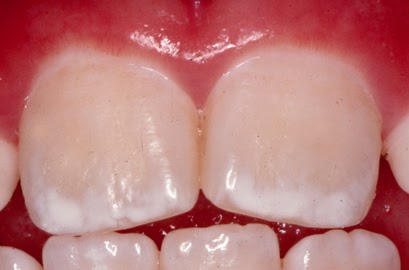Child's Teeth White Spots

The appearance of white spots on a child’s teeth can be a concerning sight for parents, often prompting questions about the cause and potential treatments. These spots, which can vary in size and appearance, are usually a sign of early stages of tooth decay or other conditions affecting the enamel. Understanding the reasons behind these white spots and knowing how to address them is crucial for maintaining good oral health in children.
One of the primary causes of white spots on children’s teeth is fluoride overdose, particularly in areas where the water supply has high levels of fluoride. When children ingest too much fluoride during the formation of their teeth, it can lead to a condition known as dental fluorosis. Mild cases of dental fluorosis may appear as small, white, lacy markings or spots on the teeth, while more severe cases can cause the enamel to become pitted or discolored.
Another common reason for white spots is enamel hypoplasia, a condition where the enamel does not form properly. This can be due to various factors, including genetics, premature birth, or nutritional deficiencies during the tooth development stage. Enamel hypoplasia can make teeth more susceptible to decay and may appear as white or yellowish spots on the teeth.
Poor oral hygiene is also a significant factor in the development of white spots. When bacteria in the mouth are not adequately removed through brushing and flossing, they can lead to the formation of plaque. If left untreated, plaque can cause the enamel to weaken and become more porous, leading to the appearance of white spots. This process is often reversible with proper dental care, including regular brushing with fluoride toothpaste, daily flossing, and regular dental check-ups.
Diet plays a crucial role in the health of a child’s teeth. Consuming foods and drinks high in sugar and acids can significantly increase the risk of tooth decay and white spots. Sugary substances feed the bacteria in the mouth, leading to acid production that wears away the enamel. Similarly, acidic foods and beverages can directly erode the enamel, making it weaker and more prone to white spots.
Given the potential causes of white spots on children’s teeth, prevention is key. Encouraging good oral hygiene habits from an early age is vital. This includes teaching children to brush their teeth at least twice a day with a fluoride toothpaste and to floss once a day. Regular dental visits are also crucial for early detection and treatment of any oral health issues.
For existing white spots, the approach to treatment depends on the underlying cause. In cases of mild tooth decay, fluoride treatments can help remineralize the enamel and reverse early stages of decay. More advanced cases may require fillings or other restorative treatments. For conditions like dental fluorosis or enamel hypoplasia, treatment options might include cosmetic procedures such as teeth whitening, veneers, or bonding to improve the appearance of the teeth.
Natural Remedies for White Spots
While professional dental care is essential for addressing white spots, there are also some natural remedies that can support oral health. Oil pulling, for instance, involves swishing oil (such as coconut or sesame oil) in the mouth to reduce bacteria and plaque. Although its effectiveness against white spots is anecdotal and not extensively scientifically proven, it can be a complementary practice to regular oral hygiene.
Dietary changes can also play a significant role in preventing and potentially reversing white spots. Increasing consumption of foods rich in calcium and vitamins, such as dairy products, leafy greens, and nuts, can help strengthen tooth enamel. Additionally, avoiding sugary and acidic foods and drinks can reduce the risk of tooth decay.
Implementing Preventive Measures
Preventing white spots from forming in the first place is the most effective strategy. This can be achieved through a combination of good oral hygiene practices, a healthy diet, and regular dental check-ups. Parents can also help by monitoring their child’s fluoride intake, especially in areas with fluoridated water, to avoid excessive consumption.
In conclusion, white spots on children’s teeth are a common issue that can arise from several factors, including excessive fluoride intake, poor oral hygiene, and dietary habits. Understanding the causes and taking preventive measures can significantly reduce the risk of these spots appearing. For existing white spots, seeking professional dental advice is crucial for appropriate treatment and to prevent further complications.
What are the primary causes of white spots on children’s teeth?
+The primary causes include fluoride overdose, enamel hypoplasia, poor oral hygiene, and diet high in sugars and acids.
How can white spots on teeth be prevented?
+Prevention can be achieved through good oral hygiene practices, a healthy diet low in sugars and acids, regular dental check-ups, and monitoring fluoride intake.
What are the treatment options for white spots on children’s teeth?
+Treatment options depend on the cause and severity but can include fluoride treatments, fillings, and in some cases, cosmetic procedures like veneers or bonding.
